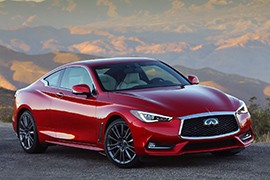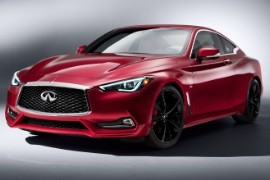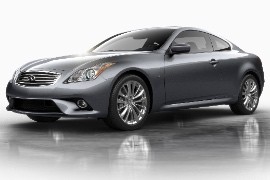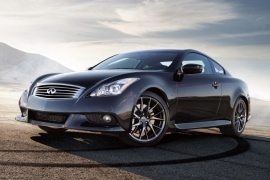INFINITI Q60 Models/Series Timeline, Specifications & Photos
First production year: 2013
Engines: Gasoline
Body style: Coupé (two-door)
Infiniti introduced the Q60 Coupe in 2018 as a replacement for its aging G-series coupe and shared its underpinnings with the Q50 Sedan.
When Infiniti unveiled the Q60 concept car at the 2015 Geneva Motor Show, there were few to believe that the Japanese premium automaker would actually build the vehicle in the same shape. Usually, concept cars are just show-offs but nothing more. However, for Infiniti, that was a moment of truth, and the end result was an almost identical vehicle. Moreover, the small changes it made to the original concept car looked even better on the production model.
With its low stance, long hood, and arched greenhouse, the Q60 looked just like it should for a personal luxury coupe vehicle. Its curved, arched lines and sharp angles made the car look like a custom build. At the front, the thick chromed rim surrounding the grille offered an upmarket image. Moreover, the sharp, human-eye-looking headlights fitted with LED and smart lighting technology enhanced the car's appearance and ensured a better night-driving experience. From its profile, the Q60 Coupe revealed an intriguing window line that formed a Z-shaped bump at the back. A reminder of the old, glorious Z-cars from Nissan.
Inside, the front seats were comfortable, with adjustable side bolsters. The aluminum trims that looked like silver carbon-fiber patterns successfully combined the sporty and elegant appearance. On the center stack, the carmaker installed a new generation of the infotainment system, with touch-screen control instead of the older, button-based unit. But despite the modern-looking features, it still relied on a foot-activated parking brake. The rear seats provided just enough headroom for shorter passengers but enough legroom.
Under the hood, Infiniti installed a choice of Mercedes-Benz-sourced inline-four, turbocharged engines and its own twin-turbocharged 3.0-liter V6 powerplant. Power went to the rear wheels via a seven-speed automatic gearbox supplied by the German carmaker.
The Infiniti Q60 Coupe was, basically, the two-door version of the Q50 sedan, but its closest relative was the Nissan 370 Z or the much famed Nissan Skyline. And that was a good thing.
Infiniti made a name of itself by building reliable, premium vehicles. Its presence in Europe was not so important and it lost the battle against the German premium car-makers.
From the outside, the design was different. It was the kind of car that made the driver stand out of the crowd. It featured a big grille with chrome surrounding and the aggressive headlights. The sloped roof looked sportier and made the car look more compact, even if it was slightly taller than the Audi A5 coupe or the BMW 4-Series.
Inside the spectacular look from the outside lost its pace. The instrument cluster looked more like traditional. On the center console, there were two screens: one for the navigation and on-board computer and the other for the infotainment unit that was Apple CarPlay and Android Auto compatible. Most of the buttons and switches are carried over by other Nissan products and, even if it had a key-less system, the actual key fob looked like the one found on the Nissan Navara pickup. In the rear, there were two seats but with very limited headroom. But, at least, the front seats were bolstered and beautifully crafted.
Under the hood, there were few engine options, starting with a 2.0-liter turbocharged unit that offered 304 hp, while the top version was a 3.0-liter twin-turbo with 405 hp. Worth mentioning that the 2.0-liter unit was a Mercedes-Benz engine and it was listed in the top 10 engines of the year at the time of its launch.
Nissan's premium brand, Infiniti, moved to the market of the luxury coupe market with the Q60. It was mostly an evolution of the former G37 coupe.
The platform was adapted from the Nissan 370Z and was longer by 50 cm (19.6”), which should lead to more legroom for the rear passengers. It was big enough to accommodate shorter persons. The headroom was also limited. The dashboard was plain and simple, with big dials on the instrument cluster for the tachometer and speedometer.
The infotainment system had a 7" screen on top of the dashboard and was controlled via buttons placed underneath it. It wasn't the top of the class, but it worked well. It was still based on the Nissan Primera's infotainment system. The 11 speakers sound system was developed by Bose and had a noise cancellation system.
The base engine for the Q60 was the 3.7-liter unit that offered 330 hp. It was mated to a standard 6-speed manual. A 7-speed automatic gearbox was fitted as an option. The Q60 Coupe was available with an all-wheel-drive system. That came with the advanced ATTESA E-TS (Advanced Total Traction Engineering System for All Electronic Torque Split) all-wheel-drive system taken from the much-acclaimed GT-R. The system utilized an active torque distribution management system with an active center clutch.
Infiniti introduced the Q60 lineup in 2013 as a replacement for the previous G37 coupe, and the top-spec version of it was the Infiniti Performance Line, or IPL for short.
Nissan’s premium brand Infiniti introduced the IPL grade in 2010, trying to push its cars into a more competitive segment of the premium coupes. At first, it used it on the G37S, and the results were somehow diminished due to the world financial crisis. However, the Japanese brand didn’t give up that easily and continued offering IPL products to the market. In 2013, the automaker rebadged the G37 as the Q60, aligning the two-door vehicle with the naming system adopted by the rest of the Infiniti brand. Unsurprisingly, in the same year, it launched the Q60 IPL for the 2014 model year, promising that customers would enjoy the new version even more than the previous G37S Coupe. The automaker made some modifications to the car, apart from the nameplate.
At the front, the six-slat chromed grille where the brand’s badge took center stage didn’t differ from the rest of the Q60 range. It was flanked by unusually shaped headlights that featured a double curvature on their upper area, while their outer sides were wrapped around the corners. On the lower side of the bumper, the automaker placed a trapezoidal-shaped central air intake flanked by side scoops that housed the fog lamps and black finishes. Finally, underneath the apron, Infiniti installed a lip spoiler to increase downforce.
From its profile, the 2014 Infiniti Q60 IPL boasted its 19-inch Y-shaped double spoke wheels, specific for the grade. To further emphasize the car’s sporty character, the car manufacturer added aerodynamically profiled side sills that stretched between the front and rear wheel arches. The low-slung greenhouse was identical to the rest of the Q60 range, but the rear end was slightly different. It featured a dual exhaust system with large pipes.
Inside, the high-bolstered front seats were 12-way adjustable for the driver and 8-way for the side passenger. Both could move forward at the touch of a button to help ingress and egress for those seated in the back. Between the front occupants, the automaker installed a center console that housed the gear stick (or the gear selector for the automatic transmission), a small storage area, and the handbrake. Atop the center stack, Infiniti placed the screen for the infotainment system, which could be controlled via a panel with physical buttons. Fronting the driver was a mixed instrument panel featuring two large dials for the speedometer and tachometer and an LCD between them that showed additional data from the car’s onboard computer. As an option, customers could get the car with a moonroof.
However, the most significant upgrades compared to the rest of the Q60 range were found under the car’s skin. Its re-tuned and calibrated engine provided 18 PS (17 hp) more than the regular Q60, thanks to high-flow catalytic converters. Infiniti sold the vehicle fitted with a 3.7-liter V6 powerplant paired with a six-speed manual or a seven-speed automatic (dual clutch) transmission.



